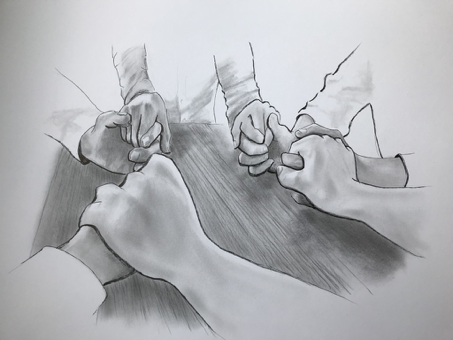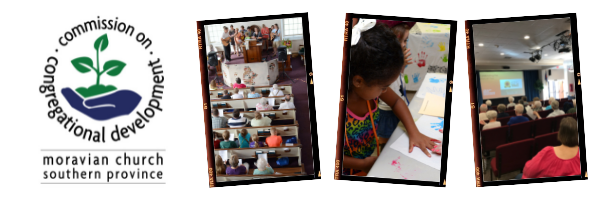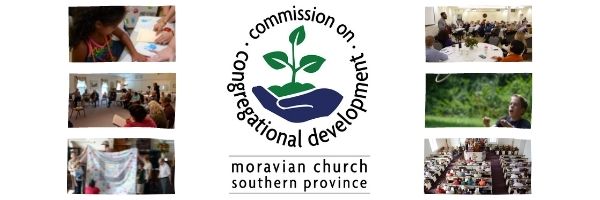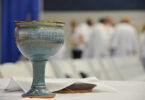 BY WILLIAM NEEDS |
BY WILLIAM NEEDS |
Note: This is part of a monthly blog series, “Coffee with Moravian Ancestors.” Bill sits down with important figures in the Moravian church to have a cup of (Moravian) coffee, asking questions about his or her life and how they have impacted the church! Look for Bill’s other blog posts here. To accompany his blog posts, he has drawn the images from his trip to Europe on the Roots of the Moravian Church Tour. For more art, visit Bill’s website at BillNeeds.com.
__________________________
Throughout the 1600s the Augsburg Treaty allowed protestant Lutheran and Calvinist “Reformed” churches to legally and peacefully coexist with Roman churches, recognized as “state churches” across northern Europe. England’s monarchy established the Anglican Church and nearly eliminated the Roman Church in Great Britain. The Roman Church standardized the term “Catholicism” in Southern Europe and followed state-sponsored explorers into the New World.
Some break-away groups splintered from mainstream protestant churches under the name “societies” (i.e. Pilgrims, Puritans, Quakers, Baptist, Anabaptist). Usually shunned and denied the right to own property, many joined the migration to the Americas to claim land for settlement, commerce, and social tranquility.
In the first quarter of the 1700s, a commune emerged in the east of Germany called Herrnhut. They encountered growing pains, of course, but after the 1727 spiritual event, Herrnhut leaders directed their attention to housekeeping tasks to develop a unique pietistic community. They reorganized goals to serve the oppressed and to spread a message of God’s love to all. Worship began and ended each day embellished by harmonic vocal and instrumental music. Quality social services and boarding schools provided disciplined education and promoted evangelism. Herrnhut thrived and became the second center of pietism seeming to rival Halle.
By providing sanctuary for religious refugees, Zinzendorf did not plan to create a new church nor resuscitate the old church from Bohemia. On the contrary, he thought Herrnhut settlers would eagerly become “a church within the existing Lutheran Church” of Berthelsdorf. But, when he saw the spiritual fruits blossom among the Moravian settlers, he reconsidered Herrnhut’s potential to become a model for other pietistic societies under the roof of any established local church; Lutheran, Reformed, or even Roman Catholic. His vision was that ecumenical.
Many refugees arriving in Herrnhut had a diverse set of leadership skills to supplement those of Christian David. There were 5 churchmen from the Moravian village of Zauchtenthal; Melchior Zeisberger (father of the apostle to the America Indians), John Toeltschig (who would become one of the first preachers in Yorkshire, England), and 3 were cousins confusingly named David Nitschmann. David Nitschmann, the carpenter, and his wife had an exceptional family, the youngest of which would cast her influence upon the Moravian Church for generations. Anna Nitschmann was just a child but gifted with unusual qualities.
Coffee with Anna Nitschmann (1715-1760)
Q. Sister Anna, I know Count Zinzendorf promoted unique ideas for “community” among the Moravians. I’d like to hear about your impressions, but first would you tell me about what you think prepared you for your Herrnhut experience?
A. I remember my early childhood in Kunwald where my father, David Nitschmann, worked as a carpenter but also secretly served as a lay pastor for the Brethren. We had no church of course. One night while leading worship with neighbors at our home, authorities heard us and arrested my father and brother. It was illegal to be one of the outlawed Brethren, let alone worship as a group! My father and brother were jailed then tortured. I was 9 years old when allowed to visit them in prison and that image still touches me deeply. When they escaped we fled to Herrnhut.
I was a fun-loving child, but with a serious streak … “old for my age” some would say. For example, I was 12 when I organized a small group of girls to form a little club; a miniature church congregation with the familiar “prayer banden” structure practiced by adults. Even though I was the youngest and smallest, I was chosen to be a leader.
Elders noticed our little group “playing church.” The entire congregation was beginning to reorganize and they were amused to see our childish attempt to copy their style of participative community.
When the time came to add individuals to the Board of Elders, it was decided that a woman be considered. Names of four women were submitted. My name was one of four, mostly as a joke I think. But an awkward moment came when my name was approved. After some squirming, the Board of Elders agreed to let the matter be decided by the lot. Again, my name was approved. I was only 14 then and, despite my age and gender, I was thrust into the world of adults with adult responsibilities that impacted the church and social life of Herrnhut. I was humbled by the opportunity and confident it was God’s will. One item on the Elders’ agenda when I joined was the implementation of a “choir” system to deepen the spiritual life of Herrnhut.

100 YEARS OF PRAYER – continues around the world today: The Unity Prayer Watch | | Drawing by Bill Needs
Q. Let’s back up a minute. You mention “banden and choirs” but I don’t know exactly what these terms mean. Would you give more explanation?
A. Let me answer with a comparison. Villages are typically composed of social units called families, right? This is what Herrnhut looked like before the Brotherly Agreement and probably what your community looks like today.
Remember, signing the Brotherly Agreement in May of 1727 seemed to ignite a feeling of, well, brotherly love. And that desire for a more caring neighborhood was a catalyst to form groups to pray and to speak about current issues of the heart, groups we called “banden.” Banden worked well as a technique to unite the communal structure of our community.
However, in Zinzendorf’s estimation, that was not enough. He preached that each person was placed on earth with God-given talents intended not only for personal edification but also to glorify God throughout life. As the community embraced his message, options were discussed in banden meetings to better support Zinzendorf’s ideal.
With the spiritual awakening of August 13, Herrnhut’s leaders made it a priority to take the notion of God-serving to another level. The concept of “choirs” evolved to complement the social unification offered by banden and the self-serving dynamics found in family structures.
The concept took a few years to grow but with time a social order for Herrnhut evolved, establishing social networks fitting developmental needs unique to individuals in each network. Groups of Little Boys, Little Girls, Older Boys, Older Girls, Single Brothers, Single Sisters, Married Couples, Widowers, and Widows became networks called choirs. Each choir was a support group whose members worshiped together, labored together, ate together, and learned together according to their developmental needs within their respective choir group. The concept even went so far as providing what might be considered “dormitory rooms” for Single Brothers, as did Single Sisters.
Oversight was offered by the Elders. Discipline was admonished when behaviors were unbecoming. Each choir had a leader and each leader gave regular accounting to the Deacons and to Count Zinzendorf. The role parents played in the upbringing of their own child was largely directed by the choir.
I don’t know if the choir system might compare to that of a modern military boot-camp, or a prep-school. I do know each participant of a choir developed a sense of esprit de corps and unique mental, spiritual and experiential training for what lay ahead.
Q. That sounds terribly restrictive. Was there a rebellion?
A. Is there rebellion in an army or on a sports team? Any discontent was immediately and prayerfully considered and dealt with by choir leaders. If it couldn’t be resolved there, the Elders would resolve it by lot. It was a system that seemed to work.
I understand you may think this restrictive, but you must remember we were now FREE compared to our life only 8 years earlier. I had seen my own father bloody from his beatings in Kunwald because of his belief. He could have died there like so many who didn’t recant.
Here, although subservient to the choir system, we were free to serve the purposes of Herrnhut; and the community of Herrnhut was free to serve our Lord. Of course, families remained intact. Of course, prayer banden continued. But the choir system provided us real-time examples and consistent messaging for pious living.
Q. OK, now I think I understand how choirs fit into Herrnhut’s version of communal living. How does this fit into the expansion of the Moravian Church into the world?
A. While Herrnhut worked internally on perfecting the choir system, Count Zinzendorf was receiving numerous external inquiries. It was becoming obvious that many noblemen throughout Germany and neighboring states considered Herrnhut worthy of imitation.
The secret to Herrnhut’s success was our devotion to God’s work, even in secular matters. Our village had gone through some rough times getting to this point – an experience not to be wished on established villages. But their inquiries deserved a civil response.
To answer any inquiries with appropriate study and discernment, it was decided to send Brethren who had displayed these qualities in the banden. They had proven themselves to be well-qualified ambassadors.
With the approval of Elders, they were sent out in all directions armed with a short historical account of Herrnhut but encouraged to establish pietistic societies within the local church, be it Lutheran, Calvinist, even Roman Catholic. They were called “Herrnhuters.” Some were sent to Sweden, Hungary, Austria, and Switzerland; to Baltic Provinces, Livonia, and Estonia; to the Czech communities of Moravia and Bohemia. Some were sent to the King of Norway and the Queen of England and, in London, to open negotiations with the Society for Promoting Christian Knowledge.

Anna Nitschmann
Q. Did the Moravian Church grow in Europe from this missionary effort?
A. No! It is important to remember that terms of the Augsburg Treaty allowed only Lutheran and Calvinist doctrines to stand alongside the Catholic Church. Zinzendorf didn’t dare cross that line, to encourage another “church.” Therefore, in a few years around 1730, this effort became known as a “diaspora of Herrnhuters” to inquiring communities.
They left behind hundreds of diaspora societies in local churches they visited. In the meantime, Count Zinzendorf, the perpetual dreamer, floated another idea to the Elders in Herrnhut – to take the message of Jesus to oppressed people in foreign lands.
Q. Oh, so was the Moravian mission effort given life by Zinzendorf’s idea?
A. Well, yes and no. In 1645, Comenius had written, “evangelization of the heathen is an imperative obligation for a living church.” In his studies at Halle, this concept resonated with Zinzendorf. As early as 1727, Zinzendorf sent Brothers David and John Nitschmann to Copenhagen to see if the crown might consider Moravian Brethren aiding the struggling Lutheran colony and mission in Greenland. That offer was declined.
I must admit that my family was enchanted by the Count’s farsighted vision and childlike enthusiasm. Everyone wanted to share the story of God’s blessing beyond our borders, but just how would that happen?
An answer came when in 1731 Count Zinzendorf returned from Denmark. While attending the coronation of his friend King Christian VI of Denmark, he met a Lutheran missionary and three converts, two from Greenland and a freed slave from the West Indies. Inspired by their stories, he described his encounter to Moravian Elders and we were all smitten with the idea that God, all along, was preparing all of us, the Moravian Brothers and Sisters to enter a much larger world of mission work!
In days to come, I never heard a negative thought about this ludicrous idea; about how in the world our little church could pull this off. Everyone simply knew, in the depth of their hearts, that this was the plan of our Creator.
Q. How did the idea of Moravian missions change your life?
A. We Elders voted in total agreement to the foreign mission idea. Some even volunteered to go on the spot! Zinzendorf could now tell King Christian that he had an army of missionaries in Herrnhut, willing and ready to go! This army included my father, then my mother. The choir system was developing so my care and feeding were not an issue. We all agreed I should live in the newly erected Single Sisters house.
I instantly took to the serenity and spiritual growth provided in this social network of likeminded women. Life in the Sisters’ house was a welcome separation from my duties as an Elder. With the title “Eldress,” I took my “job” seriously. After all, I was a teenager trying to prove my worth among adult men. I devoted extra effort to the spiritual needs of the Sisters of Herrnhut and my dedication was noticed. My experience living in the Sisters’ house contributed to my insight into the workings of all choirs, thus I became the “go-to person” for advice on choir implementation and operation.
Q. It’s amazing that your influence was so pronounced at such a young age. You became the Eldress for all women in Herrnhut, and were considered good at it! Did you feel compelled by the system of the church t0 do these things or was it your personal desire?
A. My personal desire had always been to serve a strict pious life. Of course, I had thought about marriage, it was tradition. Expected of most women, I would follow if that was to be my future. But I strongly felt that decision should be my own guided by my own relationship with the Lord, not dependent upon tradition nor designed by the Elders of the Unitas Fratrum.
I know some older Brethren saw my independent nature as haughty behavior, unbecoming of a woman, but my unusual gifts (and maybe my gender too – remember the Elders thought I was “cute” playing church only a few years prior) minimized any misgivings. My opinion and instincts were respected by most Elders and also noticed by Count Zinzendorf.
I lived in the Single Sisters’ house for only a year before Zinzendorf approached me, suggesting I leave the Single Sisters house in Herrnhut and move into their castle in Berthelsdorf to serve as a governess for his children, 9-year-old Benigna, and 11-year-old Christian. It broke my heart to leave my friends and responsibilities of the Sisters’ House in 1733, but this invitation confirmed that I was being led to a life of Christian action rather than a life of seclusion found in a choir or in a marriage. My closest friend became Zinzendorf’s daughter, Benigna, who, despite our age difference (I was 18 and she 9) helped me deal with my move from the Sisters’ House.
Q. That’s interesting. I would have expected Count Zinzendorf would prefer you to direct all your talents exclusively to the development of the choir system. How did that change your relationship with the Count and Countess, Erdmuth Dorthea?
A. My duties as Eldress for Herrnhut women did not diminish. I easily shuttled the 2 miles between Herrnhut and Berthelsdorf when needed. During the next 3 years, I began to realize this invitation would enhance my teaching skills, shape my social skills, and deepen my spirituality. I had access to Zinzendorf’s library for both instructing the children and for my own education. I met with leaders of Europe’s Pietist movement as they passed through his doors.
I was able to observe the energy and enthusiasm that Count Zinzendorf brought to everything he pursued, especially in his drive to spread the influence of his faith through all the tools at his disposal. He was highly devoted to serving the Lord, although sometimes his enthusiasm seemed like unfettered childish excitement.
I also observed Erdmuth’s style of running the household. Like the Count, she had been born into nobility and was well trained by her mother in the intricacies of managing an estate. She brought rational stability and counterbalance to the Count’s excitability. Living among the nobility was, needless to say, quite different from living under the roof of a carpenter.
Then Reverend August Spangenberg arrived in 1733. Not an immigrant but a Lutheran pastor, Zinzendorf introduced him as his instructor to help him prepare for ordination in the Lutheran Church. Spangenberg stayed longer and longer, becoming an important adjunct to the Count. He helped by administering the development of Moravian Missions in Europe, England, and abroad.
From my vantage point inside the Zinzendorf household, I saw the organization unfolding. I came to consider Count Zinzendorf as “Executive Director” of Herrnhut’s Moravian enterprise; his wife Erdmuth Dorthea the “Chief Financial Officer” (she also ran Herrnhut’s orphanage and the count’s print shop); and Spangenberg the “Chief Operations Officer.” Spangenberg became indispensable for his ability to dispatch and manage “ambassadors” from Herrnhut across Europe with one consistent objective – to tell the influence of Christ upon Herrnhut and to encourage the formation of pietist societies for Christian fellowship under the local church.
Q. Let’s see, you arrived in Herrnhut when you were 9. You experienced the August 13 renewal at age 12. You were consecrated as the first female Elder at age 14 when the choir system was being implemented in Herrnhut. You were 16 when personal circumstances brought you into the Sisters’ House, and at age 18, you moved into the royal house of Zinzendorf. You became an insider with a unique perspective on developments. What did you see evolve?
A. I couldn’t help but be impressed with how the unique presence of diaspora societies in local churches grew the reputation of the Moravians across Europe. What I missed seeing was the growing disapproval of some Saxon neighbors toward the Count. Zinzendorf had been threatened of losing Herrnhut in 1729 when political forces wished to expel the immigrants living in Herrnhut. When the court ruled in his favor he decided to legally incorporate Herrnhut, divest it from the Berthelsdorf estate, and sell it to his wife and business partner, Erdmuth Dorthea. This legal maneuver reduced the threat of removing the settlers from Herrnhut but not his exposure to punishment.
In 1734 the legal challenge arose again. There’s no denying scores had illegally crossed the border from Moravia, including my family, making us undocumented immigrants sheltered by a member of the German aristocracy. Even his own half brother and aunt disapproved of his eccentric ventures. This time, political enemies united with leaders of Halle who felt the reputation of Herrnhut was overcoming their reputation as a leader in Pietistic practices. This time the charges would stick. In 1736 Count Zinzendorf was banished from Saxony.
Q. Banishment is not used in modern times. Would you give me more information about this practice?
A. Banishment was a political technique to reduce the effect of “rabble-rousers” by taking such leaders away from their audience. In typical Zinzendorf fashion, he saw this punishment as another opportunity created by God to add to his audience for Christ.
Anticipating changes from this political discontent, he traveled incognito in 1735 into Switzerland and South Germany on a mission, but also to find sanctuary, if needed. He chose a dilapidated castle in Marienborn in the state of Wetterau, north of Frankfurt, where he could invest his energy, fortune, and Christian devotion into a new gospel-spreading enterprise fashioned after the Herrnhut experience.
I joined the Zinzendorf family and others in the move from Herrnhut to the Ronnenburg Castle. The Ronnenburg Castle was not inviting. It had become a dirty run-down “low-income rental house” already occupied by vagabond settlers of various faiths, or no faith. Zinzendorf called us his “Pilgrim Congregation” and there (contrary to the cautionary advice of Christian David) began our ministry to this sorry lot. Meanwhile, Zinzendorf proceeded to purchase land nearby and began plans to erect a second Herrnhut community to be called Herrnhaag (in English “under the Lord’s care”).
Herrnhaag became another communal spiritual center for the Moravian Church, similar to Herrnhut. As Herrnhaag was being built, we settled into a sister city of Marienborn nearby and continued our religious rituals of song, study, and prayer just as we did in Herrnhut. In time our community became a strategic stop-over point for missionaries being sent from training in Herrnhut to port cities of Europe. Herrnhaag was 6 days travel by coach from Herrnhut in the East; 8 days from Copenhagen in the North; and two weeks from London in the West. My father, August Spangenberg, Christian David, and David Zeisberger were notable among others who used this as a meeting house to pray and plan the distribution of personnel and resources across Europe, England, and into foreign lands.
Since Countess Erdmuth Dorthea was not banned from Saxony as was the Count, she was free to come and go. She agreed to spend most of her time in Berthelsdorf to administer the Zinzendorf contractual investments of schools, orphanages, print shops, and the village of Herrnhut.
Benigna and I were also free to travel. As Benigna entered her teens, I continued her instruction both in Herrnhut and Herrnhaag. I also accompanied Zinzendorf occasionally as he traveled across Europe supporting the diaspora movement, thus continuing my exposure to and instruction in his version of pietism, while I offered my opinion on his plans to expand Moravian influence in Europe and overseas.
Q. You described the Moravians as having started diaspora societies in churches across Europe. Now you suggest communities “modeled after Herrnhut” in Europe and missions into foreign lands, all arising from a backwater community of 600. This is hard to believe! You must tell me more about this.
A. ‘Sorry, I’m way ahead of myself. This story will continue after you hear about how the Moravian Mission effort evolved. I understand this will begin with your next “Coffee with Reverend Hans Egede from the Lutheran Church”.
In the meantime, I hope my comments help you understand how unique the Moravian Church was, and continues to be, in offering hope to oppressed people of the world. I encourage you to consider your own talents no matter how great or small. If my words inspire you, let me suggest you ask God to direct your talents for His service. I pray God to bless your decision and action. Amen.
__________________________
About the Author

Photo courtesy of Bill Needs.
Raised in the Moravian Church in Dover Ohio, Bill graduated from Moravian College in 1962. A drop-out of Moravian Theological Seminary, Bill now lives with his wife, Sara in Marietta, Georgia. Bill’s career served disabled individuals and employers in providing realistic vocational choices as a Vocational Rehabilitation Counselor. After retirement in 2004, Bill discovered he had a previously unknown artistic talent for drawing. Now, when Bill and Sara travel, he supplements his photography record with art inspired by the scenes and experiences. For more art, visit Bill’s website at BillNeeds.com. For discussion about art or blog content, email [email protected].
Requests for republishing, click here.
Want to volunteer to write for us? Click here.









